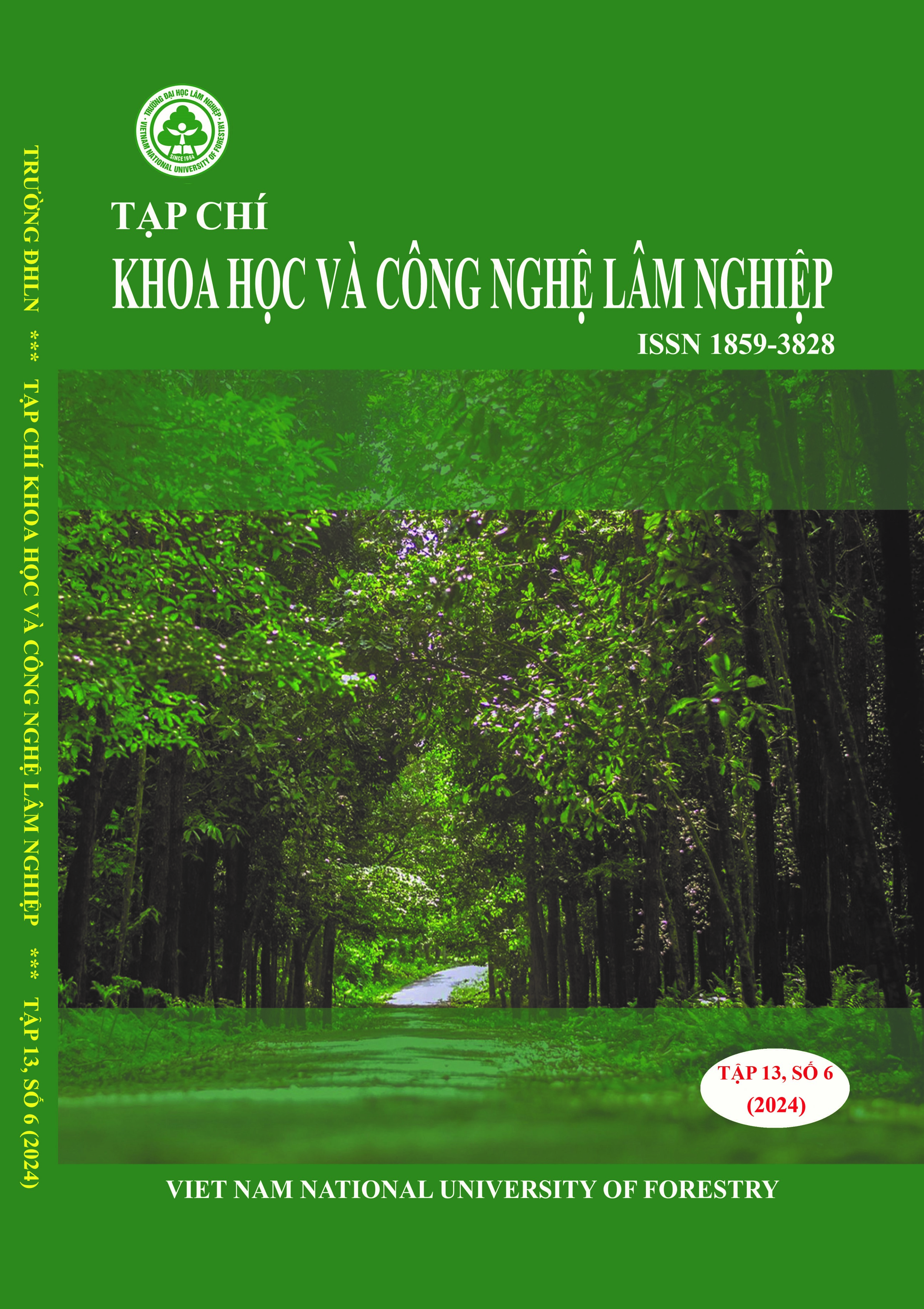Ảnh hưởng của nhiệt độ và thời gian phản ứng đến một số thông số kỹ thuật keo phenol formaldehyde phân tử lượng thấp và thử nghiệm biến tính gỗ cao su bằng phương pháp polymer hóa
DOI:
https://doi.org/10.55250/Jo.vnuf.13.6.2024.113-120Từ khóa:
Biến tính gỗ, độ hút nước, gỗ cao su, keo PF phân tử lượng thấp, polymer hóa, trương nở thể tíchTóm tắt
Bài báo này trình bày nghiên cứu ảnh hưởng của nhiệt độ và thời gian phản ứng đến các tính chất của keo phenol-formaldehyde phân tử lượng thấp (LWPF) và khả năng ứng dụng trong biến tính gỗ cao su. Các chỉ tiêu như độ nhớt, hàm lượng khô, độ tan trong nước và thời gian đóng rắn của keo PF đã được xác định thông qua các thí nghiệm đa yếu tố. Kết quả cho thấy độ nhớt của keo LWPF dao động từ 47-63 m.Pa.s và có xu hướng tăng khi nhiệt độ và thời gian phản ứng tăng. Hàm lượng khô của keo biến động từ 5,13% đến 56,2%, trong khi độ tan trong nước giảm từ 5,6 xuống 3,0 khi điều kiện phản ứng thay đổi. Thời gian đóng rắn của keo LWPF dao động từ 284-342 giây, với mối tương quan mạnh mẽ giữa nhiệt độ, thời gian phản ứng và các tính chất này. Chất lượng gỗ cao su sau khi được xử lý bằng dung dịch keo PF phân tử lượng thấp và sấy ở nhiệt độ cao đã cải thiện rõ rệt. Khối lượng gỗ tăng trung bình 29,5%, trong khi thể tích gỗ tăng 6,3%, độ hút nước khoảng 67,3%, độ trương nở chiều dày khoảng 4,5%. Các kết quả này chỉ ra rằng keo LWPF đã thâm nhập vào các khoảng trống và vách tế bào gỗ, giúp nâng cao khả năng chịu nước và giảm độ trương nở của gỗ. Nghiên cứu cung cấp cơ sở dữ liệu quan trọng cho việc tổng hợp keo PF phân tử lượng thấp và ứng dụng phương pháp ngâm tẩm kết hợp polymer hóa bằng quá trình sấy nhiệt độ cao trong biến tính gỗ cao su.
Tài liệu tham khảo
. T. Furuno, Y. Imamura & H. Kajita (2004). The modification of wood by treatment with low molecular weight phenol-formaldehyde resin: a properties enhancement with neutralized phenolic-resin and resin penetration into wood cell walls. Wood Science and Technology. 37(5): 349-361.
. Manabendra Deka & C. N. Saikia (2000). Chemical modification of wood with thermosetting resin: effect on dimensional stability and strength property. Bioresource Technology. 73(2): 179-181.
. Lý Tuấn Trường & Vũ Mạnh Tường (2016). Ảnh hưởng của thời gian sấy đến một số tính chất của compozit từ gỗ Keo lai và đơn thể phenon focmanđêhyt. Nông nghiệp và Phát triển Nông thôn. (11): 108-112.
. Andi Hermawan, Toru Nakahara, Hiroki Sakagami, Noboru Fujimoto & Kiyotaka Uchikura (2013). Performance of Sugi lamina impregnated with low-molecular weight phenolic resin. Journal of Wood Science. 59(4): 299-306.
. Stamm AJ & Seborg RM (1943). Resin-treated wood (Impreg). Research paper FPL report 1380. forest products laboratory, USDA Forest Service. 1-9.
. T. Furuno, Y. Imamura & H. Kajita (2003). The modification of wood by treatment with low molecular weight phenol-formaldehyde resin: a properties enhancement with neutralized phenolic-resin and resin penetration into wood cell walls. Wood Science and Technology. 37(5): 349-361.
. Hui Wan & Moon G. Kim (2008). Distribution of phenol-formaldehyde resin in impregnated southern pine and effects on stabilization. Wood Fiber Sci. 40(2): 181-189.
. P. V. Berdnikova, E. G. Zhizhina & Z. P. Pai (2021). Phenol-Formaldehyde Resins: Properties, Fields of Application, and Methods of Synthesis. Catalysis in Industry. 13(2): 119-124.
. Chris P. Gabrielli & Frederick A. Kamke (2010). Phenol–formaldehyde impregnation of densified wood for improved dimensional stability. Wood Science and Technology. 44(1): 95-104.
. Nguyễn Minh Ngọc & Vũ Mạnh Tường (2017). Nghiên cứu một số tính chất vật lý của compozit từ gỗ Bồ đề (Styrax tonkiensis) và nhựa phenol formaldehyde. Khoa học và Công nghệ Lâm nghiệp, Trường Đại học lâm nghiệp. (1): 61-68.
. P. Gascon-Garrido, H. Militz, C. Mai & M.-F. Thévenon (2015). Enhanced termite resistance of Scots pine (Pinus sylvestris l.) Solid wood by phenol- formaldehyde treatment. Wood Research. 60(6): 873-880.
. V. Biziks, S. Bick & H. Militz (2016). Decay resistance of beech wood and plywood treated with different type of phenol-formaldehyde (PF) resins. In: IRG (ed.) The International Research Group of Wood Protection. Stockholm, Sweden.









